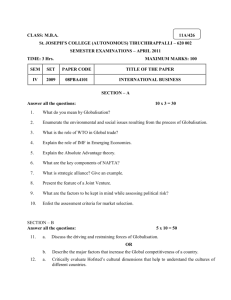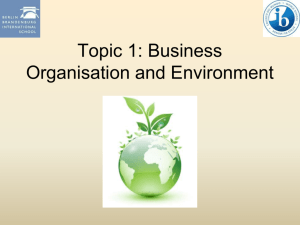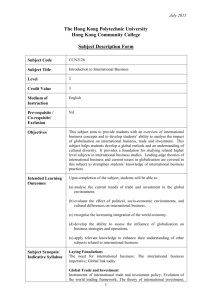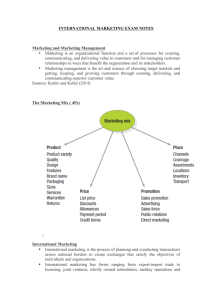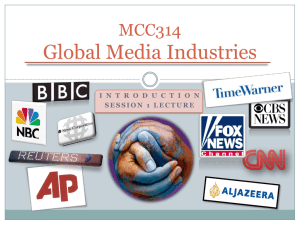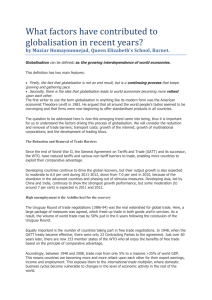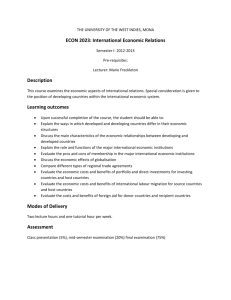File
advertisement
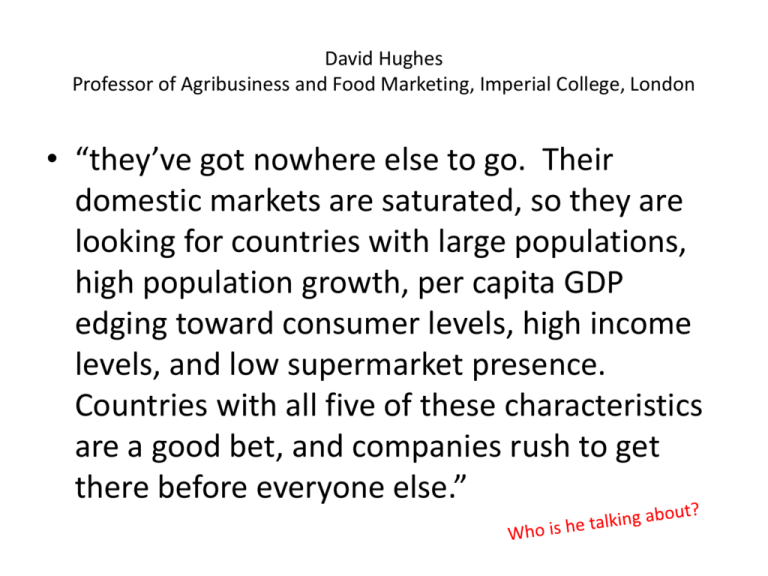
David Hughes Professor of Agribusiness and Food Marketing, Imperial College, London • “they’ve got nowhere else to go. Their domestic markets are saturated, so they are looking for countries with large populations, high population growth, per capita GDP edging toward consumer levels, high income levels, and low supermarket presence. Countries with all five of these characteristics are a good bet, and companies rush to get there before everyone else.” Tesco UK 1. Main competitors 2. Tesco’s market share International expansion strategy 1. Why? 2. Where? [USA; Poland; Slovakia; Japan; South Korea; China] 3. How? Market share Total Grocers Tesco Asda Sainsbury’s Morrisons The Co-operative Waitrose Somerfield Total Independents Iceland Aldi Lidl Netto April 2009 % 100.0% 30.6% 17.2% 16.3% 11.5% 4.4% 3.8% 3.3% 2.5% 1.8% 2.9% 2.4% 0.7% Tesco in Japan • 2001-03: research in retail markets and consumer purchasing patterns • Entry in2003 by acquisition: bought a Japanese discount supermarket chain with 78 stores using brand name Tsurukame • Continued expansion through acquisition Tesco in Poland • Entry in 1995 • Now has 100+ hypermarkets • 2006 bought 220 convenience stores from Casino [a French rival] 2005 Vodafone buys into India's Bharti Vodafone Group, the world's biggest mobile phone company, has agreed to buy a 10% stake in Indian firm Bharti Tele-Ventures for $1.5bn (£841m). 2007 India now Nokia's second market Mobile phone maker Nokia says India has overtaken the US to become its second largest market in terms of sales. 2005 Vodafone buys into India's Bharti Vodafone Group, the world's biggest mobile phone company, has agreed to buy a 10% stake in Indian firm Bharti Tele-Ventures for $1.5bn (£841m). 2007 India now Nokia's second market Mobile phone maker Nokia says India has overtaken the US to become its second largest market in terms of sales. Why have companies such as Vodafone and Nokia chosen to target developing countries as a source of revenue? To examine the meaning of global sourcing and its impact on different stakeholders Benefits And Risks Of “Make” v “Buy” “Make” - insource “Buy”-outsource Benefits: • Low risk of intellectual capital loss and technical know-how • High level of control • Cost savings retained in the business Benefits: • Guaranteed and significant cost reductions • Focus on core competencies • Supplier will get Increased scale advantages from having many clients Risks: • Large investment required to establish infrastructure, technology and personnel • High systems/technology maintenance costs Risks: • Higher risk of loss of intellectual capital and technical know-how • Costs savings shared with supplier To examine the meaning of global sourcing and its impact on different stakeholders Make v. Buy Decision Pressures to Insource/Outsource Outsource Insource High value added High levels of control required High risk/uncertainty Low value added ? No need/desire to control Low risk/uncertainty To examine factors which have made increased globalisation possible What is Globalisation ? The increased freedom and capacity of individuals and firms to: undertake economic transactions with residents of other countries operate on a global scale To examine factors which have made increased globalisation possible Examples of Globalisation Firms moving to lower cost locations People moving to higher wage locations Goods moving more freely around the world Information moving more freely around the world To examine factors which have made increased globalisation possible Permissive factors Improvements in transport links Improvements in communication links A reduction in official obstacles/barriers and costs in conducting business with foreigners To examine factors which have made increased globalisation possible To examine factors which have made increased globalisation possible Containerisation To examine factors which have made increased globalisation possible To examine factors which have made increased globalisation possible Permissive factors Improvements in transport links Improvements in communication links A reduction in official obstacles/barriers and costs in conducting business with foreigners To examine factors which have made increased globalisation possible To examine factors which have made increased globalisation possible To examine factors which have made increased globalisation possible Permissive factors Improvements in transport links Improvements in communication links A reduction in official obstacles/barriers and costs in conducting business with foreigners To examine factors which have made increased globalisation possible Average Tariffs in Industrial Countries 50 40% 40 30 20 15% 10 4.5% 0 Post. War 1960's Now • The WTO deals with the rules of trade between countries • It developed from the General Agreement on Tariffs and Trade (GATT) • WTO agreements set the ground rules for international commerce To examine factors which have made increased globalisation possible Since WW2 there has been an exceptional growth in world trade. Total trade in 2000 was 22-times the level of 1950. The ten benefits 1. The system helps promote peace 2. Disputes are handled constructively 3. Rules make life easier for all 4. Freer trade cuts the costs of living 5. It provides more choice of products and qualities 6. Trade raises incomes 7. Trade stimulates economic growth 8. The basic principles make life more efficient 9. Governments are shielded from lobbying 10. The system encourages good government 1. How does trade help a. firms stay competitive b. consumers improve their living standards 2. What does ‘liberalisation of world trade’ mean? 3. How does the ‘safe harbours’ example illustrate the work of the WTO in making trade easier? 4. What is a boycott? Would it be a good idea to boycott goods made by child labour? 5. What is meant by trade sanctions? What examples are there of trade sanctions having been used? To examine factors which have made increased globalisation possible the impact of reduced trade and other barriers in the EU The European Union the impact of reduced trade and other barriers in the EU the impact of reduced trade and other barriers in the EU Japan, the EU, and the USA 130m 500m the impact of reduced trade and other barriers in the EU 300m Trading within the EU bloc Benefits of trading blocs The economies of scale argument Greater efficiency argument Consumer benefits Problems with trading blocs The Common External Tariff ‘We pay more for our food’ argument Protection imposes costs upon others and is inefficient the impact of reduced trade and other barriers in the EU Trading within the EU bloc Benefits of trading blocs The economies of scale argument Greater efficiency argument Consumer benefits the impact of reduced trade and other barriers in the EU Trading within the EU bloc Problems with trading blocs The Common External Tariff ‘We pay more for our food’ argument Protection imposes costs upon others and is inefficient the impact of reduced trade and other barriers in the EU Trading within the EU bloc Benefits of trading blocs The economies of scale argument Greater efficiency argument Consumer benefits Problems with trading blocs The Common External Tariff ‘We pay more for our food’ argument Protection imposes costs upon others and is inefficient the impact of reduced trade and other barriers in the EU Different views UK interests best served within the EU [1973 position] UK should leave the EU [pre-1973 position] the impact of reduced trade and other barriers in the EU Different views The European market in goods, labour and capital [1993 onwards] has benefitted the majority of Europeans The EU should be just about free trade in goods [pre 1992 situation] the impact of reduced trade and other barriers in the EU Different views The EU single market works best with a single currency [the euro since 2002] and a European Central Bank which sets interest rates for the Eurozone. The European single market in goods, labour and capital [1993 onwards] has benefitted the majority of Europeans the impact of reduced trade and other barriers in the EU Different views The European single market needs to integrate further by introducing tax harmonization The EU single market works best with a single currency [the euro since 2002] and a European Central Bank which sets interest rates for the Eurozone. the impact of reduced trade and other barriers in the EU the impact of reduced trade and other barriers in the EU the impact of reduced trade and other barriers in the EU The European Union the impact of reduced trade and other barriers in the EU
